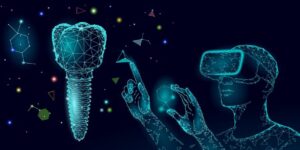
3d tooth innovation virtual reality polygonal concept. Stomatology symbol low poly triangle. Abstract oral dental medical care business. Connected dot particle modern vector illustration.
Artificial intelligence (AI) and machine learning (ML) have made significant strides in the field of dentistry, with the potential to transform the way dental practices operate and improve patient outcomes. Dental professionals are increasingly turning to AI and ML technologies to assist in a variety of tasks, from diagnosis and treatment planning to image analysis and patient communication.
One area where AI and ML have shown promise is in the early detection of oral cancer. By analyzing images and data from patients’ dental records, AI algorithms can identify potential signs of oral cancer at an early stage, allowing for more effective treatment and better patient outcomes.
Another application of AI and ML in dentistry is in the development of personalised treatment plans. By taking into account a patient’s unique dental history, genetics, and other factors, AI algorithms can help dental professionals develop tailored treatment plans that are more likely to be effective.
AI and ML are also being used to improve the accuracy of dental imaging. By analyzing X-rays and other images, AI algorithms can identify potential issues that might be missed by human observers. This can lead to earlier diagnosis and treatment of dental problems, resulting in better outcomes for patients.
Finally, AI and ML are being used to improve patient communication and education. Dental practices are using chatbots and other AI-powered tools to answer patient questions and provide information about dental procedures and treatments. This can help patients feel more informed and confident about their dental care, leading to better overall outcomes.
In summary, AI and ML technologies are rapidly transforming the field of dentistry, with the potential to improve diagnosis, treatment planning, imaging accuracy, patient communication, and overall patient outcomes. Dental professionals who embrace these technologies are likely to be at the forefront of the field, providing better care for their patients and driving innovation in the dental industry.
